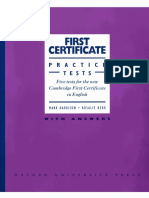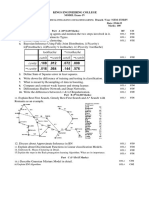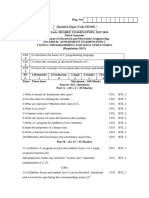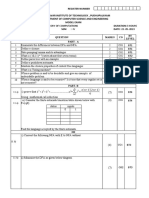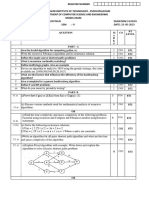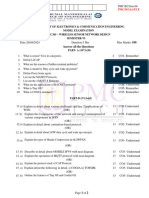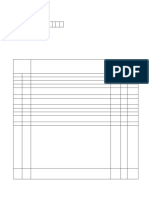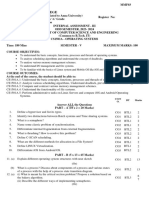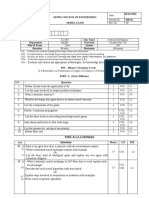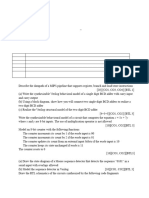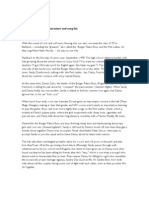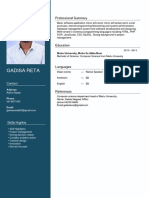0 ratings0% found this document useful (0 votes)
9 viewsDSF Model Question
DSF Model Question
Uploaded by
vinodhaCopyright:
© All Rights Reserved
Available Formats
Download as DOCX, PDF, TXT or read online from Scribd
DSF Model Question
DSF Model Question
Uploaded by
vinodha0 ratings0% found this document useful (0 votes)
9 views2 pagesOriginal Title
Dsf Model Question
Copyright
© © All Rights Reserved
Available Formats
DOCX, PDF, TXT or read online from Scribd
Share this document
Did you find this document useful?
Is this content inappropriate?
Copyright:
© All Rights Reserved
Available Formats
Download as DOCX, PDF, TXT or read online from Scribd
Download as docx, pdf, or txt
0 ratings0% found this document useful (0 votes)
9 views2 pagesDSF Model Question
DSF Model Question
Uploaded by
vinodhaCopyright:
© All Rights Reserved
Available Formats
Download as DOCX, PDF, TXT or read online from Scribd
Download as docx, pdf, or txt
You are on page 1of 2
REGISTER NUMBER:
NELLIANDAVAR INSTITUTE OF TECHNOLOGY
DEPARTMENT OF COMPUTER SCIENCE AND ENGINEERING
MODEL EXAM
DEPARTMENT: COMMON TO CIVIL,MECH &EEE- III SEM: VI
COURSE TITLE: DATA SCIENCE FUNDAMENTALS CODE: OCS353
MAX MARKS: 100 DATE&DURATION: 30.05.2024& 3 HR
Q.NO QUESTION MARKS CO BT
LEVEL
PART A
1. What is data science ? 2 CO1 BT1
2. Mention the characteristics of big data? 2 CO1 BT3
3. Difference between Pandas and NumPy. 2 CO2 BT4
4. Define pivot table. 2 CO2 BT3
5. What is machine learning? 2 CO3 BT3
6. What is meant by K-means algorithm? 2 CO3 BT1
7. Define Matplotlib. 2 CO4 BT2
8. Define kernel density. 2 CO4 BT1
9. What is meant by Map Reduce algorithm? 2 CO5 BT2
10. Mention the three generation programming tips for dealing CO5
2 BT3
with large data sets.
PART B
11.a) Explain the data science process and its steps in detail. 13 CO1 BT2
OR
b) Write a short notes on data mining and its details. 13 CO1 BT1
12.a) Explain the basic details of NumPy Arrays CO2 BT4
OR
b) Explain the different way of constructing a pandas Data 13 CO2 BT3
Frame.
13.a) Explain the types of Machine learning. 13 CO3 BT1
OR
b) Explain in detail about Outlier analysis. 13 CO3 BT2
14.a) Explain in detail about simple line plots. 13 CO4 BT2
OR
b) Explain in detail about three dimensional plotting on mat lab. 13 CO4 BT6
15.a) Explain in detail about the problems that you face when
13 CO5 BT2
handling large data.
OR
b). Explain the case study Predicting Malicious URLs. 13 CO5 BT6
PART C
16.a) Explain in detail about Hierarchical Indexing. 15 CO2 BT2
OR
16.b) Explain in detail about aggregation operations in python. 15 CO2 BT1
COURSES OUTCOME:
S.NO QUESTION PAPER CO’S
1 1,2,11a,11b) CO1
2 3,4,12a,12b,16a,16b) CO2
3 5,6,13a,13b) CO3
4 7,8,14a,14b) CO4
5 9,10,15a,15b) CO5
BLOOM’S TAXOMAOMY:
BT1- Remember, BT2-Understand, BT3- Apply, BT4- Analyze, BT5- Evaluate, BT6- Create
Level BT1 BT2 BT3 BT4 BT5 BT6
percentage 27.2% 27.2% 22.7% 9.09% - 9.09%
COURSE INSTRUCTOR HOD PRINCIPAL
You might also like
- 【DSE English Paper 3 2024】卷三聆聽綜合格式✅必學技巧【Part A & B齊全】 - Spencer Lam English TeamDocument1 page【DSE English Paper 3 2024】卷三聆聽綜合格式✅必學技巧【Part A & B齊全】 - Spencer Lam English TeamMing Yan TamNo ratings yet
- First Certificate Practice Tests With Answers (M. Harrison, R. Kerr)Document162 pagesFirst Certificate Practice Tests With Answers (M. Harrison, R. Kerr)Karolina93% (14)
- CDDDDocument2 pagesCDDDGaja LakshmiNo ratings yet
- DW QueDocument1 pageDW QueRajiNo ratings yet
- AIML Model4Document1 pageAIML Model4nkhavoc9789No ratings yet
- CSS341 - DW Model QP Set BDocument2 pagesCSS341 - DW Model QP Set BksathishkmNo ratings yet
- BDA ModelDocument2 pagesBDA Modelramya.cseNo ratings yet
- Dbms Model ExamDocument2 pagesDbms Model ExamragunathNo ratings yet
- CS3301 Ds ModelDocument1 pageCS3301 Ds ModelMakendran RamakittuNo ratings yet
- CPDS Iae1Document2 pagesCPDS Iae1saveetha.cseNo ratings yet
- CN QueDocument1 pageCN QueRajiNo ratings yet
- CSS341 - DW Model QP Set ADocument2 pagesCSS341 - DW Model QP Set AksathishkmNo ratings yet
- 3CSE CS3591-CNDocument10 pages3CSE CS3591-CNSUBRAMANIAN PITCHAINo ratings yet
- DDM Model QPDocument2 pagesDDM Model QPmusiczone358No ratings yet
- Part A 10 2 20: Course In-Charge Ahod HOD PrincipalDocument1 pagePart A 10 2 20: Course In-Charge Ahod HOD PrincipalBala913No ratings yet
- Toc Modelexam Qp-NbaDocument3 pagesToc Modelexam Qp-NbaragunathNo ratings yet
- CIA-1 - CS3353 - CPDS Question Paper PCDocument6 pagesCIA-1 - CS3353 - CPDS Question Paper PCksathishkmNo ratings yet
- Algorithms Modeexam Qp-NbaDocument3 pagesAlgorithms Modeexam Qp-NbaragunathNo ratings yet
- cd3291 Datastructure and Algorithms Revision 1Document1 pagecd3291 Datastructure and Algorithms Revision 1keerthigaNo ratings yet
- Question Bank C++Document5 pagesQuestion Bank C++Jai Shree RamNo ratings yet
- Model Oose Set 1Document4 pagesModel Oose Set 1kheerthana.20No ratings yet
- CCS375 - WT Cia - 2 QBDocument3 pagesCCS375 - WT Cia - 2 QBjalini.sNo ratings yet
- Bvrajuinstitute Oftechnology, Narsap UR: Code No: A27AF R15Document1 pageBvrajuinstitute Oftechnology, Narsap UR: Code No: A27AF R15rajeshNo ratings yet
- Data Analytics Model Question Paper P21CS601 NewDocument3 pagesData Analytics Model Question Paper P21CS601 Newprathikshapshetty7No ratings yet
- Answer ALL Questions. Each Question Carries 05 MarksDocument1 pageAnswer ALL Questions. Each Question Carries 05 MarksSultan AhmadNo ratings yet
- BCA309 Data Structures Using C QBDocument22 pagesBCA309 Data Structures Using C QBpornisbad4healthNo ratings yet
- Cec365 Model Set1Document2 pagesCec365 Model Set1suryabmepco23No ratings yet
- EC1602A - CN - QB All UnitsDocument5 pagesEC1602A - CN - QB All UnitsLavanya PriyaNo ratings yet
- PCCN Mid I Sep-2024Document3 pagesPCCN Mid I Sep-2024nanipavan830No ratings yet
- 3 AI&DS AD3501-DL (1)Document10 pages3 AI&DS AD3501-DL (1)SUBRAMANIAN PITCHAINo ratings yet
- Dbms Model QuesDocument1 pageDbms Model QuesMakendran RamakittuNo ratings yet
- CN-model Qps-June 2023Document6 pagesCN-model Qps-June 2023wooyoung654No ratings yet
- Lords Institute of Engineering & Technology (A) : Unit 1Document2 pagesLords Institute of Engineering & Technology (A) : Unit 1TAMMISETTY VIJAY KUMARNo ratings yet
- Edge and Fog Computing IAT 1Document2 pagesEdge and Fog Computing IAT 1S Veerakumar ECE KIOTNo ratings yet
- Os - Set 2Document2 pagesOs - Set 2saraswathiNo ratings yet
- MODEL QP FOR AI&DS alphaDocument2 pagesMODEL QP FOR AI&DS alphaithodNo ratings yet
- Fe - Ec - Sem-I - Home Assignment No - Iii - 15-3-23 PDFDocument1 pageFe - Ec - Sem-I - Home Assignment No - Iii - 15-3-23 PDFRajveer Singh SachdevNo ratings yet
- S.Y. B.Tech. (Computer Science & Engineering) : End Semester Examination, December-2021Document1 pageS.Y. B.Tech. (Computer Science & Engineering) : End Semester Examination, December-2021A.K. GamingNo ratings yet
- Data warehouse IMP QUESTIONS CS3551Document2 pagesData warehouse IMP QUESTIONS CS3551placementproject28No ratings yet
- Internal Test II DpcoDocument2 pagesInternal Test II DpcomaheshwariNo ratings yet
- 19ECE349 - VI Sem May 2022Document3 pages19ECE349 - VI Sem May 2022karthiksuvines11No ratings yet
- 9-Model Question Paper I-Sem-2023Document2 pages9-Model Question Paper I-Sem-2023Sathish Kumar KurapatiNo ratings yet
- RNS Institute of Technology: Department of MCA V Semester - II Test - Oct 2018 Internet of Things (16MCA552)Document1 pageRNS Institute of Technology: Department of MCA V Semester - II Test - Oct 2018 Internet of Things (16MCA552)Average KannadigaNo ratings yet
- Part A 10 2 20: Course In-Charge Ahod HOD PrincipalDocument1 pagePart A 10 2 20: Course In-Charge Ahod HOD PrincipalBala913No ratings yet
- Deep Learning QP Ia ! Sep 2024Document2 pagesDeep Learning QP Ia ! Sep 2024kathiravana2004No ratings yet
- CS3351 - ModelDocument2 pagesCS3351 - Modelrkkumar07No ratings yet
- QB - Part A, B & C StatisticsDocument6 pagesQB - Part A, B & C StatisticsPragatheeswaran shankarNo ratings yet
- DAA Model Question PaperDocument2 pagesDAA Model Question PaperrevathiNo ratings yet
- Valliammai Engineering College: Department of Electronics and Communication EngineeringDocument9 pagesValliammai Engineering College: Department of Electronics and Communication EngineeringCecilia ChinnaNo ratings yet
- BI - Previous Year QuesDocument2 pagesBI - Previous Year QuesabhkhikNo ratings yet
- FODSQNDocument9 pagesFODSQNsecondyear2325No ratings yet
- 20CS4501ADocument3 pages20CS4501A22501a05c6No ratings yet
- Ids QB PDFDocument4 pagesIds QB PDFKeertanaNo ratings yet
- Adobe Scan Nov 12, 2024Document2 pagesAdobe Scan Nov 12, 2024hariharankb.mechNo ratings yet
- QP - Dev - Ia 2Document2 pagesQP - Dev - Ia 2Tamil KNo ratings yet
- III-II Regular DMDW Model PaperDocument2 pagesIII-II Regular DMDW Model PaperKrishna ChandraNo ratings yet
- Assignment 2 - (ML) (MSE)Document2 pagesAssignment 2 - (ML) (MSE)Saurabh LomteNo ratings yet
- COA Question Bank - CO MappingDocument3 pagesCOA Question Bank - CO MappingKomalNo ratings yet
- Ete551 - Jan2022Document2 pagesEte551 - Jan2022KushagraNo ratings yet
- Dsa Iat 1Document3 pagesDsa Iat 1Shruthi SNo ratings yet
- 20AI7PE53_Grid Computing_QBDocument7 pages20AI7PE53_Grid Computing_QBreddyjamanlaNo ratings yet
- Functional and Physical Properties of Polymer NanocompositesFrom EverandFunctional and Physical Properties of Polymer NanocompositesAravind DasariNo ratings yet
- Customers MIDCDocument9 pagesCustomers MIDCRahul TambareNo ratings yet
- Fundamentals of Group DynamicsDocument10 pagesFundamentals of Group DynamicsAvril SalenNo ratings yet
- Routledge Handbook of Sport Gender and Sexuality 1st Edition Jennifer Hargreaves 2024 Scribd DownloadDocument72 pagesRoutledge Handbook of Sport Gender and Sexuality 1st Edition Jennifer Hargreaves 2024 Scribd Downloadpincaysohane100% (12)
- California University of Pennsylvania's 2015-2020 Strategic PlanDocument23 pagesCalifornia University of Pennsylvania's 2015-2020 Strategic PlanImran Zahid100% (1)
- 7 Habits For Effective Customer ServiceDocument31 pages7 Habits For Effective Customer Servicehesty2024No ratings yet
- What Is The Relationship Between Economics and PsychologyDocument3 pagesWhat Is The Relationship Between Economics and PsychologyNino GodoradzeNo ratings yet
- 1st Module AssessmentDocument7 pages1st Module AssessmentAjay KumarNo ratings yet
- ResumeDocument2 pagesResumeapi-302491782No ratings yet
- Philo DLL June 11Document3 pagesPhilo DLL June 11Mhay Anne PerezNo ratings yet
- LD Lac Classroom ManagementDocument11 pagesLD Lac Classroom ManagementMary Grace De QuirozNo ratings yet
- Narrative On Tulong Kulong-Kulong para Sa PagdunongDocument3 pagesNarrative On Tulong Kulong-Kulong para Sa Pagdunongsherrel anislagNo ratings yet
- Project Completion Certificate FormatDocument1 pageProject Completion Certificate FormatRaj Kumar Madhavaraj0% (2)
- Disaster & SafetyDocument11 pagesDisaster & SafetyFatima BahaaNo ratings yet
- GREASE - Synopsis, Characters and Song ListDocument5 pagesGREASE - Synopsis, Characters and Song ListKrisna NingsihNo ratings yet
- CHN Teaching PlanDocument18 pagesCHN Teaching Planfaith neoNo ratings yet
- Cohen-Vogel Et Al., 2015Document38 pagesCohen-Vogel Et Al., 2015Giancarlo Coral LeonNo ratings yet
- Design Anthropological Futures - Rachel Charlotte SmithDocument305 pagesDesign Anthropological Futures - Rachel Charlotte SmithAlejandra Trejo-PooNo ratings yet
- Ielts Academic Top Nationality Frequency 2022Document4 pagesIelts Academic Top Nationality Frequency 2022Anh Trần TrungNo ratings yet
- Gadisa Reta CVDocument1 pageGadisa Reta CVGadisa RetaNo ratings yet
- Subject Practice Activities: English in The Community: General InformationDocument12 pagesSubject Practice Activities: English in The Community: General InformationJulio Medina100% (1)
- Guided Reading ScriptDocument9 pagesGuided Reading Scriptapi-285821636No ratings yet
- Tef ConnectDocument1 pageTef ConnectSalammathieu4No ratings yet
- Inu111 - Review Units 1-2Document9 pagesInu111 - Review Units 1-2britishgirl05No ratings yet
- Mcgill Library e ThesisDocument5 pagesMcgill Library e Thesishod1beh0dik3100% (2)
- New Roles of Libraries in 21st Century - Nazarbayev UniversityDocument29 pagesNew Roles of Libraries in 21st Century - Nazarbayev UniversitySher Baz nighaNo ratings yet
- Sample MBA Cover Letter: Boston ConsultingDocument2 pagesSample MBA Cover Letter: Boston ConsultingSudip MukkawarNo ratings yet
- DLP Eng 6 Q1 Identify Real or Make Believe Fact or Non Fact ImagesDocument8 pagesDLP Eng 6 Q1 Identify Real or Make Believe Fact or Non Fact ImagesLemuel MoradaNo ratings yet
- Grade 3 Mother Tongue Most Essential Learning Competencies MELCsDocument4 pagesGrade 3 Mother Tongue Most Essential Learning Competencies MELCsAllyn Madelo100% (1)

